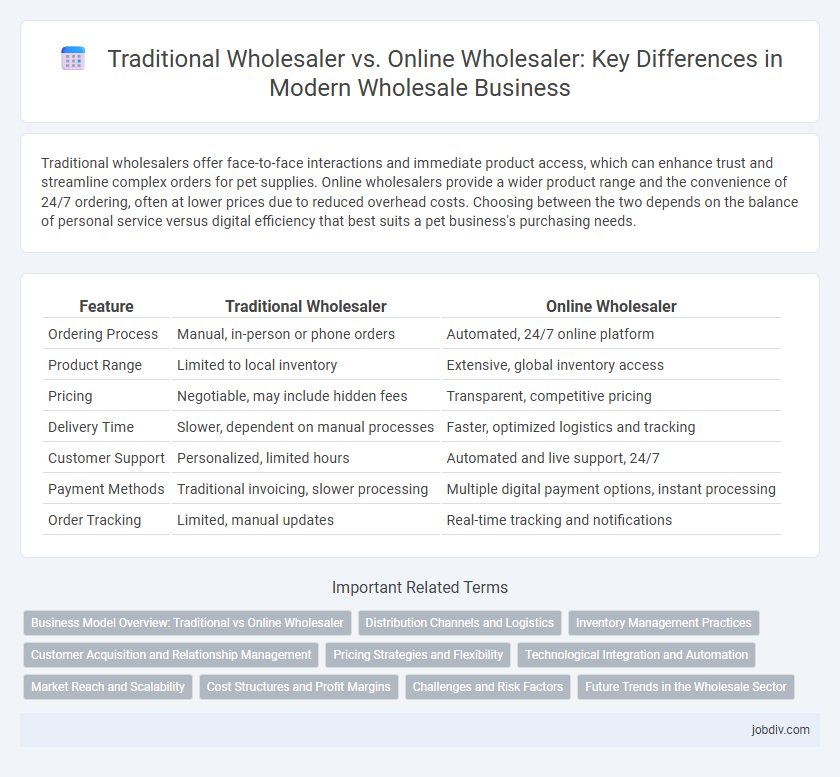Traditional wholesalers offer face-to-face interactions and immediate product access, which can enhance trust and streamline complex orders for pet supplies. Online wholesalers provide a wider product range and the convenience of 24/7 ordering, often at lower prices due to reduced overhead costs. Choosing between the two depends on the balance of personal service versus digital efficiency that best suits a pet business's purchasing needs.
Table of Comparison
| Feature | Traditional Wholesaler | Online Wholesaler |
|---|---|---|
| Ordering Process | Manual, in-person or phone orders | Automated, 24/7 online platform |
| Product Range | Limited to local inventory | Extensive, global inventory access |
| Pricing | Negotiable, may include hidden fees | Transparent, competitive pricing |
| Delivery Time | Slower, dependent on manual processes | Faster, optimized logistics and tracking |
| Customer Support | Personalized, limited hours | Automated and live support, 24/7 |
| Payment Methods | Traditional invoicing, slower processing | Multiple digital payment options, instant processing |
| Order Tracking | Limited, manual updates | Real-time tracking and notifications |
Business Model Overview: Traditional vs Online Wholesaler
Traditional wholesalers operate through physical warehouses and face-to-face transactions, relying heavily on local relationships and direct inventory management to serve retailers. Online wholesalers utilize digital platforms to connect with a broader customer base, leveraging automated order processing, real-time inventory tracking, and global supply chains for enhanced scalability and efficiency. The contrast in business models highlights traditional wholesalers' emphasis on in-person service versus online wholesalers' focus on technology-driven convenience and expanded market reach.
Distribution Channels and Logistics
Traditional wholesalers rely on physical distribution channels, utilizing regional warehouses and direct store deliveries to ensure product availability. Online wholesalers leverage digital platforms combined with centralized fulfillment centers, enabling efficient order processing and faster shipping across broader geographic markets. The integration of advanced logistics technologies in online wholesale improves inventory management and reduces delivery times compared to conventional methods.
Inventory Management Practices
Traditional wholesalers often rely on manual inventory tracking systems, leading to potential delays and errors in stock replenishment. Online wholesalers utilize advanced inventory management software and real-time data analytics, enabling more accurate stock levels and faster order processing. Efficient inventory management in online wholesaling reduces holding costs and improves customer satisfaction through timely deliveries.
Customer Acquisition and Relationship Management
Traditional wholesalers rely heavily on personal relationships and in-person interactions to acquire customers and maintain loyalty, often leveraging local networks and face-to-face trust-building. Online wholesalers utilize digital marketing strategies, data analytics, and automated communication tools to attract a broader audience and streamline customer relationship management. The digital platform allows for efficient scaling while maintaining personalized service through CRM software and targeted content delivery.
Pricing Strategies and Flexibility
Traditional wholesalers often adopt fixed pricing strategies with limited flexibility, relying on established relationships and bulk order discounts to maintain profit margins. In contrast, online wholesalers leverage dynamic pricing models powered by real-time data analytics, enabling rapid price adjustments to market demand and competitive positioning. This flexibility in pricing allows online wholesalers to attract a broader customer base and respond swiftly to changing market conditions.
Technological Integration and Automation
Traditional wholesalers generally rely on manual processes, face-to-face interactions, and legacy inventory systems, which limit scalability and real-time data access. Online wholesalers leverage advanced technological integration such as AI-driven inventory management, automated order processing, and cloud-based platforms to enhance efficiency and customer reach. The automation in online wholesale operations reduces errors, accelerates fulfillment, and provides data analytics for strategic decision-making.
Market Reach and Scalability
Traditional wholesalers typically serve local or regional markets due to physical store limitations, resulting in constrained market reach and slower scalability. Online wholesalers leverage e-commerce platforms to access global customers instantly, enabling rapid market expansion and higher scalability with lower overhead costs. The digital model supports extensive product listings and real-time inventory updates that enhance supply chain efficiency and customer engagement.
Cost Structures and Profit Margins
Traditional wholesalers often face higher overhead costs including warehousing, staff salaries, and physical storefront expenses, which can reduce profit margins. Online wholesalers benefit from lower fixed costs due to digital platforms, automated logistics, and reduced need for physical infrastructure, enabling more competitive pricing and higher margins. Both models must strategically manage inventory turnover and operating expenses to maximize profitability within their respective cost structures.
Challenges and Risk Factors
Traditional wholesalers face challenges such as high overhead costs, limited market reach, and inventory management inefficiencies that can impact profitability. Online wholesalers encounter risks including cybersecurity threats, reliance on digital infrastructure, and intense competition in a global marketplace. Both models must navigate supply chain disruptions and shifting consumer behaviors to maintain operational resilience.
Future Trends in the Wholesale Sector
Traditional wholesalers are increasingly integrating digital platforms to streamline inventory management and expand market reach, while online wholesalers invest heavily in AI-driven analytics and automated logistics to enhance efficiency. Future trends indicate a surge in omnichannel strategies combining physical and digital assets, fostering seamless customer experiences and faster delivery times. Sustainability practices and data-driven decision-making are becoming central to competitive advantage in both traditional and online wholesale models.
Traditional Wholesaler vs Online Wholesaler Infographic

 jobdiv.com
jobdiv.com